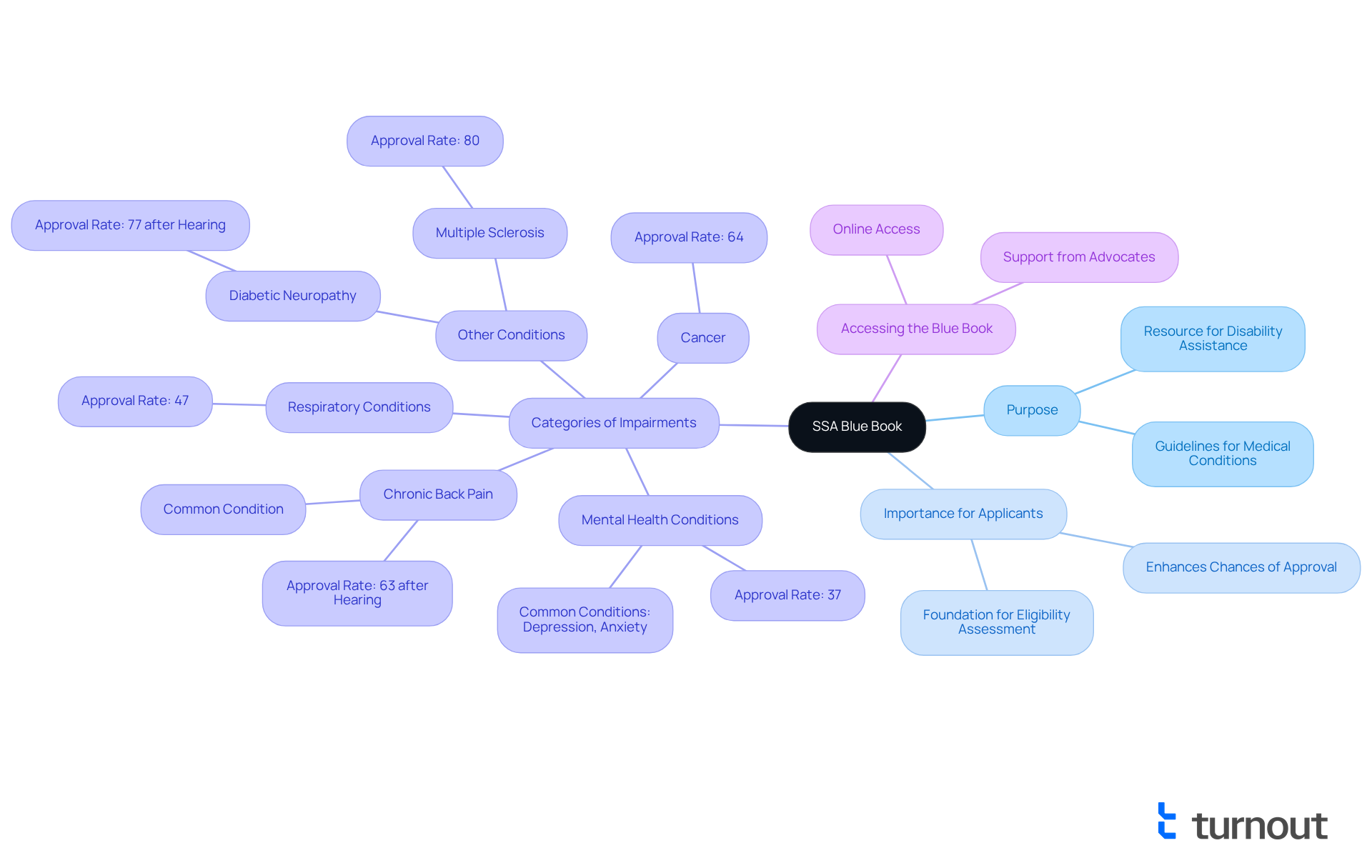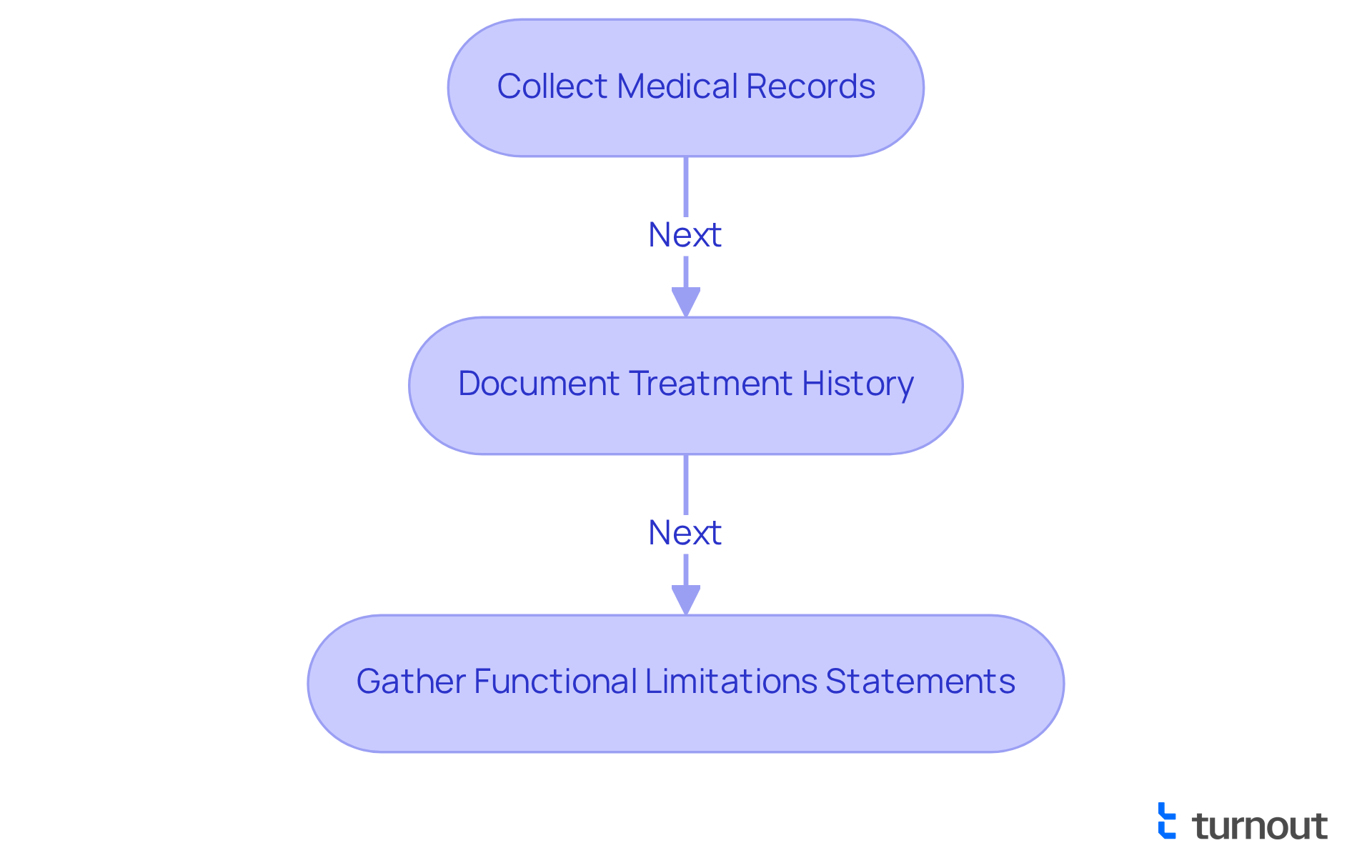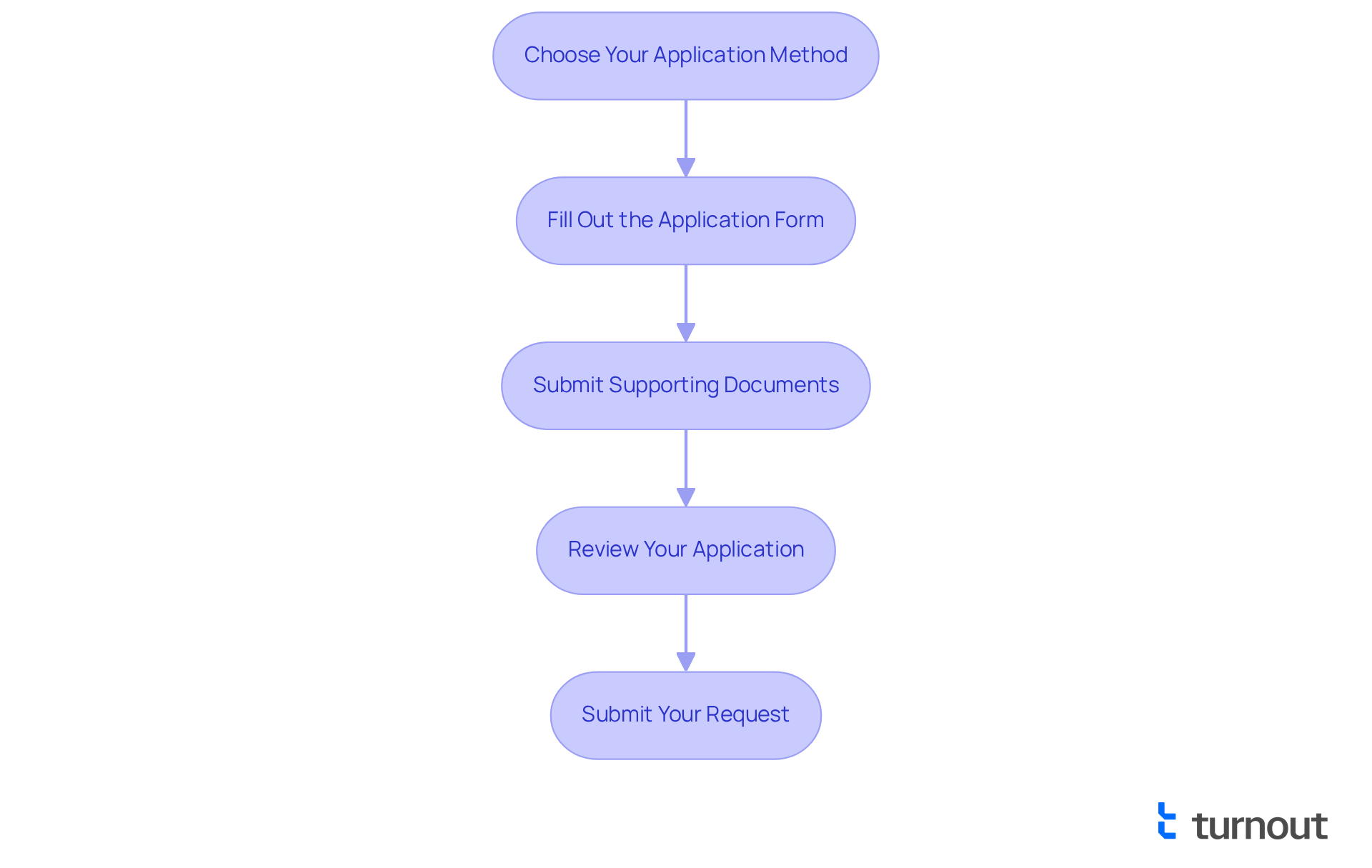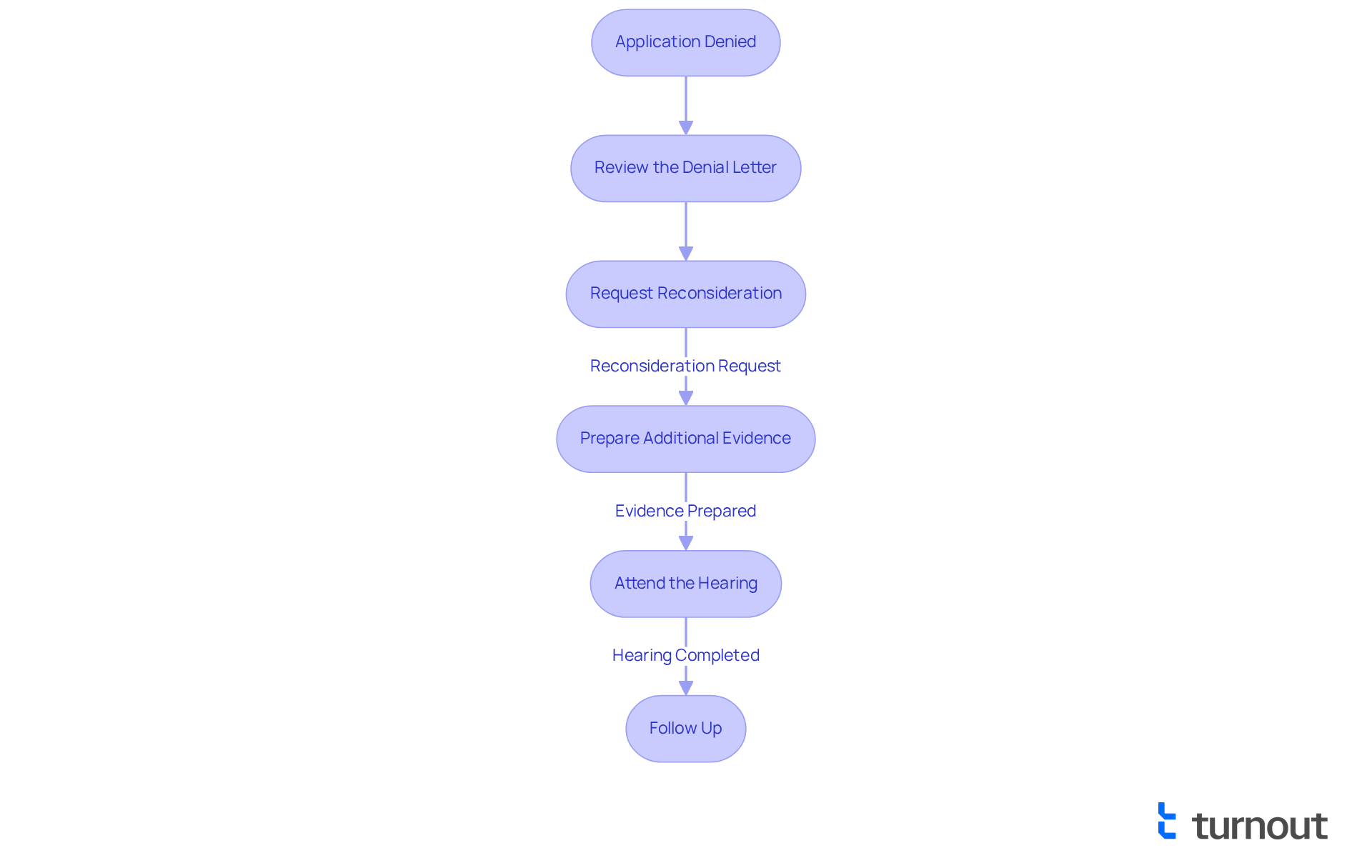Overview
Navigating the Blue Book of the Social Security Administration (SSA) can feel overwhelming, especially when you're seeking disability benefits. We understand that the process can be daunting, but we're here to help you through it. The article outlines five essential steps to guide you on this journey:
- Understanding the Blue Book
- Identifying relevant impairments
- Gathering medical evidence
- Completing the application process
- Navigating the appeals process if you face a denial
Each of these steps is crucial, and we emphasize the importance of thorough documentation. Understanding the specific criteria outlined in the Blue Book significantly enhances your chances of approval in what can be a challenging claims environment. Remember, you are not alone in this journey, and taking these steps can make a real difference in your experience.
By following this guidance, you can approach the application process with confidence and clarity. Together, let's work towards securing the support you deserve.
Introduction
Navigating the complexities of the Social Security Administration's Blue Book can be overwhelming. We understand that seeking disability benefits is a significant and often stressful journey. This essential resource outlines the medical conditions and criteria necessary for qualification, yet many applicants find themselves struggling to grasp its intricacies. By mastering the Blue Book, you can significantly enhance your chances of approval. However, with nearly 60% of initial claims denied, the stakes are undeniably high.
How can you effectively leverage this guide to overcome the challenges of the application process? It's common to feel lost or anxious, but remember, you're not alone in this journey. We're here to help you understand the steps you need to take to secure the support you deserve. Together, we can navigate this path with confidence.
Understand the SSA Blue Book and Its Purpose
The blue book ssa, which is formally known as Disability Evaluation Under Social Security, serves as an essential resource for individuals seeking disability assistance. This comprehensive guide outlines the medical conditions and impairments that may qualify for assistance. It categorizes various impairments and details the specific medical criteria required for each condition.
We understand that navigating the blue book ssa can feel overwhelming. However, comprehending this resource is crucial for anyone pursuing disability assistance, as it establishes the foundation for assessing eligibility. In 2025, fewer than 33% of initial disability claims are authorized by the SSA, highlighting the importance of a well-informed application process.
Familiarizing yourself with the blue book ssa can significantly enhance your chances of approval. It provides detailed descriptions of impairments and the necessary evidence for each condition. For instance, conditions like chronic back pain, which affects many applicants, are addressed in the blue book SSA, providing guidance on how to present your case effectively.
Disability advocates emphasize that a comprehensive understanding of the Blue Book can empower applicants, making the process of obtaining assistance more manageable and attainable. Remember, you are not alone in this journey. Turnout offers valuable tools and services, including trained nonlawyer advocates, to help you understand the blue book ssa and prepare your SSD claims.
We encourage you to access the blue book ssa online at the official SSA website. Explore its contents and gain a clearer understanding of the requirements for your specific situation. We're here to help you every step of the way.

Identify Relevant Listings and Impairments
To identify relevant listings, we encourage you to start by examining the Blue Book's sections that relate to your specific medical condition. The Blue Book is thoughtfully organized into categories based on body systems, including:
- Musculoskeletal disorders
- Respiratory conditions
- Mental disorders
Each category features detailed listings that outline the severity and specific criteria necessary for qualification. For instance, if you are dealing with a musculoskeletal disorder, focus on the section detailing criteria for conditions such as arthritis or spinal disorders. It's crucial to pay close attention to the specific requirements your condition must meet to qualify for assistance.
As we look ahead to 2025, claims related to musculoskeletal disorders are expected to be significant, reflecting the ongoing challenges many face. We understand that showing particular limitations is essential; for instance, ongoing pain or reduced mobility can greatly affect everyday functioning and enhance your submission. The SSA regards the inability to earn over $1,470 monthly in 2024 as a criterion for SSDI eligibility, emphasizing the financial consequences of qualifying for assistance. Moreover, it's important to note that roughly 60 percent of initial applications for Social Security Disability assistance are rejected, highlighting the significance of comprehending the Blue Book listings.
Turnout is here to assist you in navigating this complex process. Utilizing trained nonlawyer advocates, we provide tools and services designed to help you understand the specific criteria outlined in the Blue Book and prepare your case effectively. By thoroughly understanding the relevant listings in the Blue Book, you can better prepare your case and enhance your chances of obtaining the assistance you require. Remember, you are not alone in this journey; we’re here to help you every step of the way.

Gather Required Medical Evidence and Documentation
Collecting the necessary medical evidence is a crucial step in securing disability benefits, as outlined in the blue book SSA. We understand that this process can feel overwhelming, but acquiring comprehensive documentation from healthcare providers is essential. This documentation should detail your medical history, diagnosis, and treatment. Key components include:
-
Medical Records: It's important to request copies of your medical records from all healthcare providers who have treated you for your condition. Ensure these records encompass notes from your doctors, test results, and any imaging studies. Statistics indicate that comprehensive medical documentation significantly increases the likelihood of claim approval, as the SSA, referred to in the blue book SSA, relies heavily on this information to assess the severity of your impairment.
-
Treatment History: Documenting your treatment history meticulously is vital. Include medications prescribed, therapies undergone, and any surgeries performed. This information helps establish a clear timeline of your medical journey and the ongoing nature of your condition.
-
Functional Limitations: We encourage you to gather statements from your healthcare providers that articulate how your condition restricts your ability to perform daily activities and work-related tasks. This evidence is crucial in demonstrating the impact of your impairment on your life. Successful claimants frequently offer comprehensive descriptions of their limitations, which can be crucial in the assessment outlined in the blue book SSA.
By following these steps and ensuring that your medical documentation is thorough and well-organized, you can enhance your chances of a favorable outcome in your disability claim. Remember, you are not alone in this journey, and we’re here to help.

Complete the Application Process for Benefits
To complete the application process for disability benefits, we’re here to guide you through these important steps:
-
Choose Your Application Method: You can apply online through the SSA website, by phone, or in person at your local SSA office. Online forms are typically quicker and more effective, allowing you to save your progress and return later if needed.
-
Fill Out the Application Form: Use the blue book SSA, which includes Form SSA-16, for disability benefits. It’s essential to provide detailed information about your medical condition, work history, and how your impairment affects your daily life. Clarity and detail are vital for a successful submission, and at Turnout, our skilled nonlegal advocates are available to help you understand what information is required.
-
Submit Supporting Documents: Include all collected medical evidence and documentation with your request, such as doctor contacts and treatment records. Ensure everything is organized and clearly labeled. Missing or incorrect details can lead to delays or denials, so thoroughness is key. Turnout's approach streamlines this process by guiding you on which documents are essential.
-
Review Your Application: Before submitting, double-check all information for accuracy and completeness. Incomplete submissions can significantly impede your chances of approval. Preparation is essential for a seamless submission process, and Turnout encourages you to utilize our resources to ensure everything is in order.
-
Submit Your Request: Once you feel confident that everything is in order, submit your request and keep a copy for your records. After submission, you may be contacted by the SSA for further inquiries, and you can check the status of your request through your Social Security account dashboard.
In 2025, the SSA expects to receive millions of requests for disability benefits, emphasizing the significance of understanding the blue book SSA submission procedures. If your request is denied, remember that you have the right to contest the decision, which involves several levels of review. Recent updates to the SSA submission procedures highlight the necessity for precise and thorough entries to enhance approval rates. As one supporter mentioned, "Preparation is essential for a seamless submission experience." You are not alone in this journey; we’re here to help every step of the way.

Navigate the Appeals Process if Denied
If your application for disability benefits is denied, we understand how disheartening that can be, particularly in relation to the blue book SSA. You have the right to appeal the decision, and we’re here to guide you through the appeals process, including assistance with the blue book SSA, provided by Turnout's trained nonlawyer advocates.
-
Review the Denial Letter: Start by carefully reading the denial letter. Understanding the reasons behind the blue book SSA is crucial. This knowledge will empower you to address specific issues in your appeal. Turnout's supporters are here to help you comprehend the blue book SSA and craft a robust response.
-
Request Reconsideration: You can request a reconsideration of the decision by submitting Form SSA-561. Remember, this must be done within 60 days of receiving the denial letter. Missing this deadline could mean starting a new application, risking the loss of back benefits. Turnout can guide you through this critical step to ensure your blue book SSA is submitted on time.
-
Prepare Additional Evidence: Gather new medical evidence or documentation that supports your claim. This evidence should address the reasons for the denial. Successful appeals often depend on presenting comprehensive medical records and witness statements that clearly demonstrate the impact of your disability. Turnout's advocates can assist you in identifying and compiling the necessary evidence for the blue book SSA to strengthen your case.
-
Attend the Hearing: If your reconsideration is denied, you can request a hearing before an Administrative Law Judge (ALJ). Be prepared to present your case and any additional evidence. The ALJ hearing has a higher success rate; approximately 44% of applicants are approved at this stage. Claimants represented by advocates, including those who utilize the blue book SSA from Turnout, have a success rate of 64.3%, compared to 34.1% for those without representation. This is a critical opportunity to strengthen your claim.
-
Follow Up: After the hearing, it’s important to follow up on the status of your appeal. The process can take time, often spanning from one to three months for a decision. Patience and persistence are essential. If denied again, you can request a review by the Appeals Council of the blue book SSA, although less than 1% of cases are approved at this stage. Turnout's team is here to assist you in navigating this follow-up process as well.
By understanding these steps and preparing thoroughly with Turnout's expert guidance, you can significantly enhance your chances of a successful appeal. Remember, you are not alone in this journey; we’re here to help.

Conclusion
Navigating the SSA Blue Book can feel overwhelming for those seeking disability benefits. This essential resource outlines the medical conditions and impairments that qualify for assistance, offering clarity on eligibility criteria. By understanding this guide, you can empower yourself to present your case effectively, significantly increasing your chances of approval.
We understand that the process can be complex. Key steps include:
- Familiarizing yourself with relevant listings
- Gathering necessary medical evidence
- Completing the application accurately
- Knowing how to navigate the appeals process if faced with a denial
Each of these components is crucial in ensuring you are well-prepared and informed, enhancing your likelihood of a successful claim.
Ultimately, securing disability benefits may seem daunting, but with the right knowledge and support, it becomes more manageable. Seeking assistance from trained advocates and thoroughly understanding the SSA Blue Book can make a substantial difference. Remember, taking proactive steps—whether reviewing your medical documentation or preparing for a potential appeal—can ensure that your pursuit of benefits is as smooth and successful as possible. You are not alone in this journey; we’re here to help.
Frequently Asked Questions
What is the SSA Blue Book and its purpose?
The SSA Blue Book, formally known as Disability Evaluation Under Social Security, is a comprehensive guide that outlines the medical conditions and impairments that may qualify for disability assistance. It categorizes various impairments and details the specific medical criteria required for each condition.
Why is it important to understand the Blue Book?
Understanding the Blue Book is crucial for anyone pursuing disability assistance, as it establishes the foundation for assessing eligibility. Familiarity with its contents can significantly enhance the chances of approval for disability claims.
What is the approval rate for initial disability claims by the SSA?
In 2025, fewer than 33% of initial disability claims are expected to be authorized by the SSA, highlighting the importance of a well-informed application process.
How can I use the Blue Book to improve my disability claim?
The Blue Book provides detailed descriptions of impairments and the necessary evidence for each condition. Familiarizing yourself with the relevant listings can help you present your case effectively, improving your chances of approval.
What types of medical conditions are categorized in the Blue Book?
The Blue Book is organized into categories based on body systems, including musculoskeletal disorders, respiratory conditions, and mental disorders.
How should I identify relevant listings for my specific condition?
Start by examining the sections of the Blue Book that relate to your specific medical condition. Each category features detailed listings outlining the severity and specific criteria necessary for qualification.
What are some examples of conditions mentioned in the Blue Book?
Conditions such as chronic back pain, arthritis, and spinal disorders are addressed in the Blue Book, with specific criteria for each.
What financial criterion does the SSA use for SSDI eligibility?
The SSA regards the inability to earn over $1,470 monthly in 2024 as a criterion for SSDI eligibility.
What percentage of initial applications for Social Security Disability assistance are rejected?
Approximately 60% of initial applications for Social Security Disability assistance are rejected, underscoring the importance of understanding the Blue Book listings.
How can Turnout assist applicants in navigating the Blue Book?
Turnout offers valuable tools and services, including trained nonlawyer advocates, to help applicants understand the Blue Book and prepare their SSD claims effectively.




